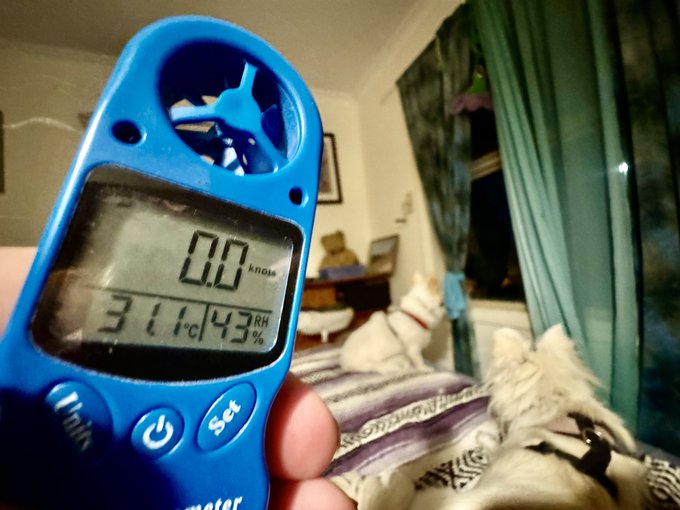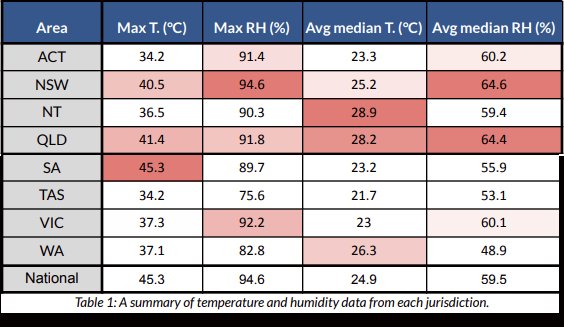
Bedroom Temperature: “BOM says 25.4C ambient temp in Fawkner at 12.40am, but in my bedroom the temperature is 31.1C.”
Over this past summer the Renters advocacy organisation Better Renting has undertaken citizen science project on how renters around Australia experience summer temperatures and heat inside their homes.
Over 100 renters around Australia monitored temperatures and humidity in their homes over summer.
Better Renting argues that their research indicates that renters are suffering through summer in rented homes that aren’t fit for purpose. To address the problems and health issues to prevent increased suffering and mortality from future heat, they suggest two key recommendations:
- introduce minimum energy performance standards for rental homes, making it mandatory for such properties to have features that make it practical and affordable to keep a home at a healthy and comfortable temperature.
- improve renters’ power in the market both to obtain a decent rental and to exercise their rights once established.
We know that Extreme heat days will double by the end of the century in Merri-bek. We are likely to see 50C extreme heat days in Melbourne, and a shrinking winter and expanding summer season due to global heating. Winter is expected to practically vanish in Merri-bek by 2050. See the projection for Pascoe Vale below:

For Victoria, renters experienced a summer that was warmer than long-term averages, but cooler than other recent summers. “Our data reflects this, showing conditions that — while still a problem — are better than those recorded elsewhere. The average median temperature was 23°C, with rental homes surpassing 25°C almost 5 hours a day.”
New South Wales renters had median indoor temperatures of 25.2°C, meaning that temperatures were above this level 50% of the time. NSW also had the worst humidity, with renters spending half their time above 65% humidity, and the highest maximum humidity — 95% — recorded in this state. Homes were above 25°C over 12 hours a day on average, with almost 1 hour a day above 30°C. Indoor temperatures exceeded outdoor temperatures over 40% of the time: when this happened, indoor temperatures averaged 28°C.
Western Australia faced what is predicted to be its hottest summer on record: it
was the second-hottest state in our dataset. Rental homes averaged 16 hours a day
above 25°C, with an average median temperature of 26.3°C. Almost 3 hours a day
rental homes were above 30°C indoors. Unlike other areas, WA was hotter
overnight, with a median temperature of 26.8°C from 10pm to 6am. When it was
hotter in than out, WA rental homes performed worst, being on average 4°C hotter
inside than out.
In South Australia, renters spent around 6 hours a day with indoor temperatures
above 25°C, including overnight, where median temperatures were hotter than
during the day. The single highest maximum temperature, 45.3°C, was also
recorded in SA. This is during a summer that was relatively cool compared to recent
and anticipated future summers.
Queensland was the hottest state in our analysis. Rental homes averaged 50% of
the time above 28.2°C, also experiencing high average humidity (64.4%). Daily,
about 6 hours were above 30°C, and night-time temperatures exceeded 25°C for
86% of the time. Indoor temperatures exceeded outdoor temperatures over 60% of
the time, during these times it was 3.9°C hotter indoors.
The wet season in the Northern Territory brought indoor conditions that were
virtually unbearable. Only 2 hours a day on average were less than 25°C, with over
8 hours a day cracking 30°C indoors. This is also true for overnight conditions,
where median temperatures were 29.3°C from 10pm to 6am.
Conditions in the ACT and Tasmania were milder. ACT had median temperatures
averaging 23.3°C, and rental homes cracked 25°C for about 4 hours a day. Tasmania
was below 25°C for 94% of the time, with a benign median temperature of 21.7°C.

Our qualitative research found that the experience of such temperature conditions was mediated by the quality of rental housing and how much financial pressure renters were under. Better housing meant that a home would warm up less, and renters had access to cooling appliances. A stronger financial position could mean being able to run AC or escape the heat by going out. Conversely, renters in worse housing would experience greater temperature variability and have fewer options to address the heat. Greater cost-of-living pressure would also mean a reluctance to use energy for mechanical cooling, and greater likelihood of being stuck at home in potentially dangerous conditions.
Overnight temperatures
Overnight temperatures were seen as a particular problem with rental accommodation remaining hot during the night. This disrupts sleep and affects people the following day. In a multi-day heatwave overnight heat can be dangerous for health, particularly for vulnerable groups such as young children, the elderly or those with existing medical conditions.

Addressing the problem
Some jurisdictions are already starting to act. The ACT has a requirement for ceiling insulation in rental homes, and Victoria is looking to expand their existing standards to include cooling.
We blogged in 2017 that Minimum standards needed for rental properties for energy efficiency and thermal tolerance. We supported in 2023 Sweltering Cities petition calling for Cooling standards needed for Victorian Renters
The report identifies that “simple features like ceiling fans, fly screens on windows and doors, and external shading, can make a dramatic difference in helping people to manage heat. These will be increasingly essential to reduce mortality risk during heatwaves. Over time, such a ‘features-based’ approach should evolve into an approach based on ‘modelled performance’: using a rating tool such as the Residential Efficiency Scorecard and requiring each rental property to meet a specified minimum standard.”
But Better Renting highlights that “In a tight rental market, where renters are under the threat of retaliatory eviction, renters struggle to achieve basic repairs, and would struggle to self-advocate in relation to energy performance standards. It is thus essential to improve the power of renters to exercise their rights.”
The full report by Better Renting makes for interesting reading. (See Below) It is time State Governments addressed renters rights, including cooling standards in rental standards.
References
Better Renting, 19 March 2024, Cruel Summers: Renters’ diverse experiences of Summer 23-24, https://www.betterrenting.org.au/renter_researcher_summer_24
Jim Malo and Kate Burke, Sydney Morning Herald, 19 March 2024, Was it really hotter inside than out this summer? 100 renters found out, https://www.smh.com.au/property/news/was-it-really-hotter-inside-than-out-this-summer-100-renters-found-out-20240315-p5fcsl.html